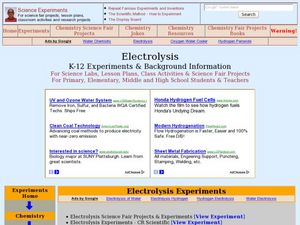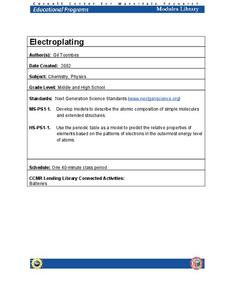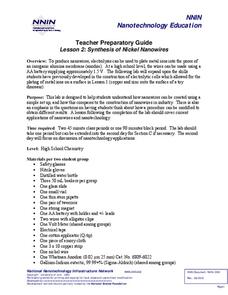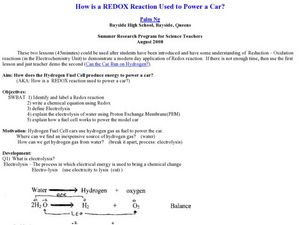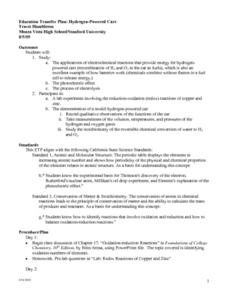Curated OER
Solar Kit Lesson #15 - Solar-Powered Electrolysis of Water and the Hydrogen Economy
An outstanding lesson awaits your physics fledglings! After reading about how hydrogen can act as an energy carrier, they examine the electrolysis of water using solar power. They test the gases produced for flammability and will...
Curated OER
Fuel Cell Experimentation
With rising oil prices and increasing concerns over global warming, the pressure is on for engineers to develop alternative sources of energy. Among the new technologies being developed are hydrogen fuel cells, which young scientists...
Curated OER
Electrolysis
Young scholars conduct a series of experiments on water electrolysis. For this chemistry lesson, students explain what happens to the molecules during the process. They cite real world applications of electrolysis.
Rochester Institute of Technology
Molecules and Fuel Cell Technology
A fuel cell is where the jailer keeps gas guzzlers. Scholars review chemical reactions, chemical bonds, and chemical structure in order to apply these concepts. Participants construct fuel cell kits, using electrolysis to run the car and...
Cornell University
Electroplating
Silver pennies and copper nickels are made possible by applying some chemistry. Learners use electrolysis to coat a penny with zinc sulfate and a nickel with copper sulfate. Their investigation builds an understanding of electroplating...
Cornell University
Build a Fuel Cell
Discover the connection between redox reactions and fuel cells. Collaborative groups build a Hoffmann Apparatus that demonstrates the electrolysis of water and then convert their models into a fuel cell. They use their fuel cells to...
National Nanotechnology Infrastructure Network
Synthesis of Nickel Nanowires
It's all about the scale—they're not just wires, they're nanowires! The second lesson of the series builds on the oxidation-reduction experiment in the first lesson. Scholars synthesize a sample of nanowires using electrolysis. As they...
Curated OER
THe Decomposition of Water
High schoolers collaborate in an experiment where they decompose water into simpler substances through the process of electrolysis. They collect, measure, and observe data and then place the data into a table. Accomodations for...
Curated OER
Construction of a Microscale Fuel Cell
Fuel cells are being called the "energy source" of the future. Allow your high school chemistry class to construct a miscroscale fuel cell, complete with all components to generate energy. This engaging activity will allow them to apply...
Curated OER
How is a REDOX Reaction Used to Power a Car?
Learners explore electrolysis and Redox reactions. In this exploratory lesson students demonstrate an example of electrolysis and how it brings on a chemical change.
Curated OER
Hydrogen- The Fuel of the Future
Learners research the importance of Hydrogen as a potential fuel source. They work in groups to used the internet in order to research this topic. They participate in an electrolysis experiment and a power point presentation in order...
Curated OER
Hydrogen Powered Cars
Young scholars apply the principles of chemistry to investigate the concept of how a hydrogen powered car works. They study the electrochemical reactions that provide the energy source. Students also record observations in the...
Curated OER
Separation of Mixtures and Compounds For K Through 12
Students explore mixtures and compounds. In this instructional activity, students do an experiment to distinguish between mixtures and compounds. Students complete ten different phases of the experiment testing many different substances....
Cornell University
Splitting Water with Electricity
Explore how electricity splits water molecules into hydrogen and oxygen. Learners begin by calculating the voltage necessary to separate the water. They then perform the experiment and measure the ratio of hydrogen and oxygen bubbles.
American Chemical Society
Middle School Chemistry: Energy Levels, Electrons, and Covalent Bonding
Young scholars discover the concept that two atoms can attract and form a covalent bond.


